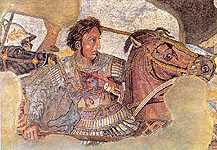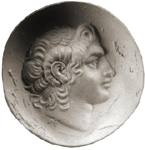
 'Alexander the Great', King of Macedon (356-323 BC), son of Philip II. He saw himself as avenger of Greece's sufferings at the hands of the Persians in the 5th century, and in a series of brilliant campaigns crushed the Persian empire, taking his Macedonian and Greek troops to the borders of India. He was regarded as an outsider by many Greeks, though he had been taught by Aristotle. His rule extended over mainland Greece, and after his premature death in Babylon his 'empire' was divided into various 'Hellenistic' dynasties. In his few years in the east he adopted many eastern practices, copying the Persian imperial court, and was ready to be regarded as a god. He was encouraged in this by an oracle from the Egyptian shrine of 'Zeus Ammon', and can be seen wearing the 'horns of Ammon' in portraits (coins and gems). He was said to have favoured particular artists for his portraits: Lysippos for sculpture, Apelles for painting, Pyrgoteles for gems.
'Alexander the Great', King of Macedon (356-323 BC), son of Philip II. He saw himself as avenger of Greece's sufferings at the hands of the Persians in the 5th century, and in a series of brilliant campaigns crushed the Persian empire, taking his Macedonian and Greek troops to the borders of India. He was regarded as an outsider by many Greeks, though he had been taught by Aristotle. His rule extended over mainland Greece, and after his premature death in Babylon his 'empire' was divided into various 'Hellenistic' dynasties. In his few years in the east he adopted many eastern practices, copying the Persian imperial court, and was ready to be regarded as a god. He was encouraged in this by an oracle from the Egyptian shrine of 'Zeus Ammon', and can be seen wearing the 'horns of Ammon' in portraits (coins and gems). He was said to have favoured particular artists for his portraits: Lysippos for sculpture, Apelles for painting, Pyrgoteles for gems.
Above left: Detail from the Alexander mosaic. Naples, National Archeological Museum © National Archeological Museum
Above right: Gem impression. Oxford 280 (1892.1499) Greek Gems and Finger Rings pl. 998. © John Boardman